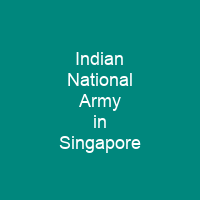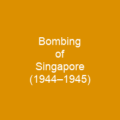The Indian National Army was an Indian military wing in Southeast Asia. It was formed with the help of the Japanese forces and was made up of roughly about 45 000 Indian POWs, who were captured after the fall of Singapore on 15 February 1942. Between 1942 and 1945, the INA was involved in various military operations fighting alongside the Japanese and against the British and Allied forces. The INa was dissolved in August 1945. Some scholars believe that the INa acted as a catalyst for the Indian independence movement.
About Indian National Army in Singapore in brief

By 1941, the morale of the Indian Army troops was very low and this set up the stage for many soldiers to switch loyalties to the Japanese in 1942. The British had already begun to suspect that not all of their Indian Army personnel were loyal to them. This was largely because the British had to resort to indiscriminate recruitment in order to maintain the numbers for its army, meaning that it was no longer carefully curating its selection for the armed forces. In 1942, the number of British-Indian troops swelled from 200 000 to 900 000 between 1939 and 1941. The number of young boys who had very little or no combat training and experience, leading to anxiety amongst the British- Indian forces. Thirdly, although it appears that the number British- Indians was growing in numbers, it was also making up a very young boys with very little combat training. This led to the British having to rely on the British Indian Army to protect them in Malaya and Singapore. This meant that the British military was beginning to be spread too thinly and they were unable to allocate much of their resources to the military set up in these areas. In 1943, Major Iwaichi Fujiwara was the officer assigned by the Japanese government to head to Bangkok to undertake efforts to “engage in Indian cooperation”. As the first step in his efforts, he sought out popular and popular support for his efforts.
You want to know more about Indian National Army in Singapore?
This page is based on the article Indian National Army in Singapore published in Wikipedia (as of Nov. 12, 2020) and was automatically summarized using artificial intelligence.







